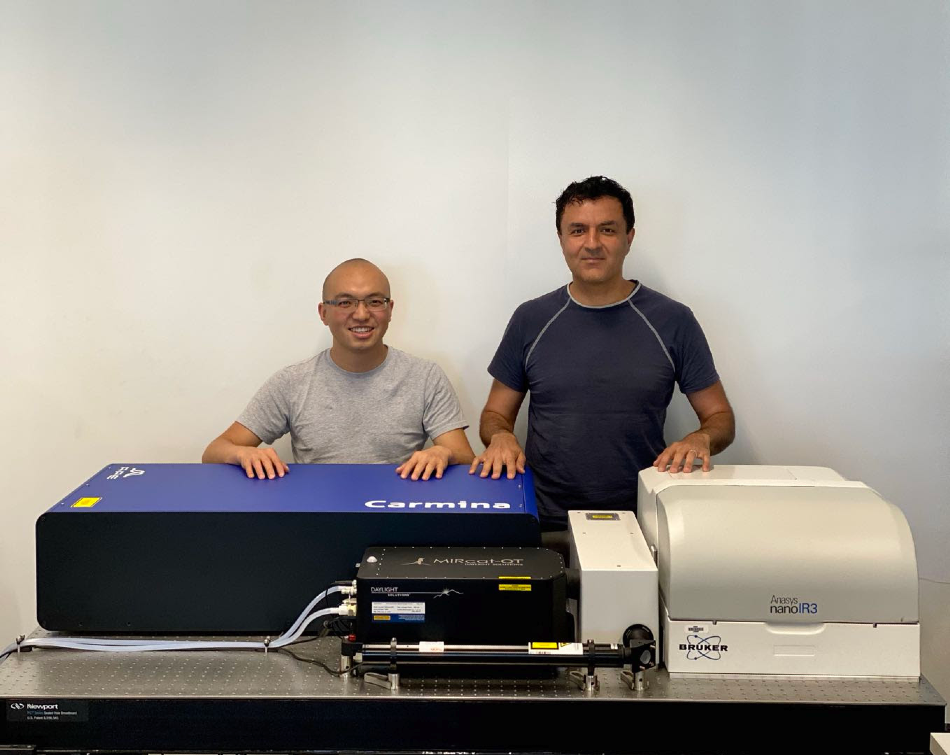Bruker’s Nano Surfaces Division reports the groundbreaking use of a nanoIR3-s Broadband™ system at the University of New South Wales (UNSW) Centre for Advanced Solid and Liquid-based Electronics and Optics (CASLEO) to provide new insights into phonon-polaritons (PhPs) in thin layered crystals of hexagonal boron nitride (hBN) on SiO2/Si wafers.
 Dr. Jiong Yang (left) and Professor Kourosh Kalantar-Zadeh (right) with their Bruker nanoIR3-s Broadband system at UNSW CASLEO.
Dr. Jiong Yang (left) and Professor Kourosh Kalantar-Zadeh (right) with their Bruker nanoIR3-s Broadband system at UNSW CASLEO.
Professor Kourosh Kalantar-Zadeh’s multidisciplinary group combined scattering-SNOM single-wavelength imaging and broadband scattering IR nanospectroscopy to resolve features in near-field amplitude spectra that had never been observed previously.
Their research, recently published by ACS Nano (DOI: 10.1021/acsnano.9b08895), systematically studied the near-field auxiliary signatures on the hBN layers between supported and suspended boundary conditions.
Such detailed information about influence from local boundaries has enormous implications for engineering and creating nanophotonic heterostructures for advanced sensing applications.
The capability of the nanoIR3-s Broadband exceeded our expectations. The signal-noise-ratio is superb. As such, we could obtain spectra as clear as spectra of a conventional FTIR at nanoscale resolutions. Excitingly, we could see new vibrational features that are generated by the boundaries that have not been reported previously."
Professor Kourosh Kalantar-Zadeh
"The wavenumber range of the nanoIR3-s Broadband is from 670 cm-1 to 4,000 cm-1 which is beyond any other system in the market, allowing us to observe spectra that have not been seen by other researchers,” added Dr. Jiong Yang. “The system’s stability, combined with the exceptionally high-power broadband laser, leads to new horizons in nanoscale spectroscopy."
“We designed the nanoIR3-s Broadband system to comprehensively address the requirements for nanoscale FTIR broadband spectroscopy and high-resolution imaging for a wide range of demanding applications,” explained Dean Dawson, Bruker’s Sr. Director and Business Manager, nano-IR Products.
“We are delighted that Professor Kalantar-Zadeh’s excellent team at CASLEO has put the system so quickly through its paces for such impactful research,” he added.
About nanoIR3-s Broadband
The nanoIR3-s Broadband system provides a unique capability for nanoscale imaging and spectroscopy over the entire mid-infrared spectral range (2.5 to 15 μm / 4000 to 670 cm-1) by coupling with a broadband light source based on a novel femtosecond OPO/DFG laser.
While featuring high laser power and wide spectral range, this laser source can also switch its linewidth for imaging and spectroscopy. Ultimately, the system provides the highest performance spectroscopy and imaging for 2D/graphene materials, while enabling nanoscale material property mapping and sample environmental control options.
About the UNSW CASLEO
The Centre for Advanced Solid and Liquid-based Electronics and Optics (CASLEO) has a mission to create novel materials and systems that have impacted and will continue to influence the well-being of people for the better.
In the past, the members of CASLEO have proven their capabilities in developing systems that have significantly influenced the areas of liquid metals, sensors, electronic materials, optics, microfluidics, and medical devices. Professor Kourosh Kalantar-Zadeh, the director of the center, has already led his group to the invention of the first ingestible chemical sensor that was successfully tested in humans.
The concept of liquid metals as reaction media was coined by Kourosh and his group. Additionally, the first report on chemical vapor deposition of two-dimensional metal chalcogenides also originated from his group.
Kourosh is one of the 2018 Australian Research Council (ARC) Laureate Fellows and is also a member of the ARC Centre of Excellence for Future Low-Energy Electronics Technologies (FLEET). CASLEO also receives funding from the National Health and Medical Research Council (NHMRC), Australia.
Source: Bruker